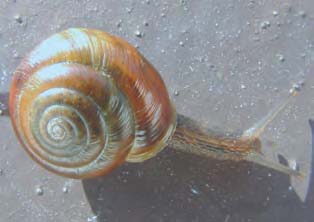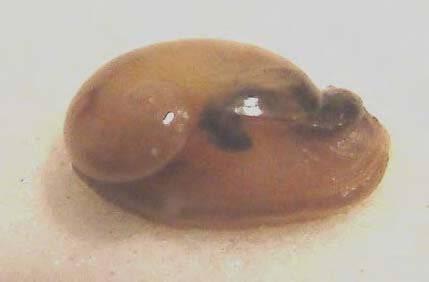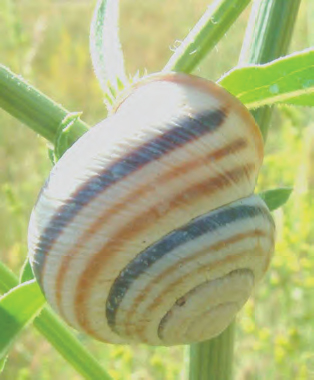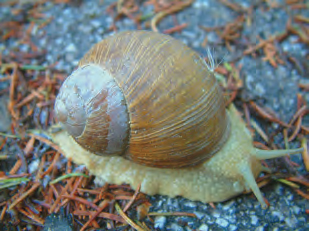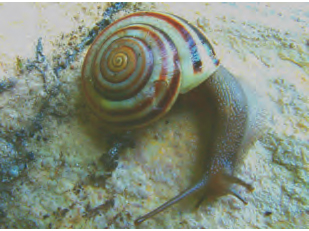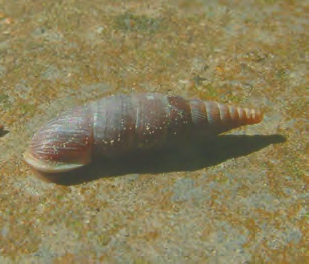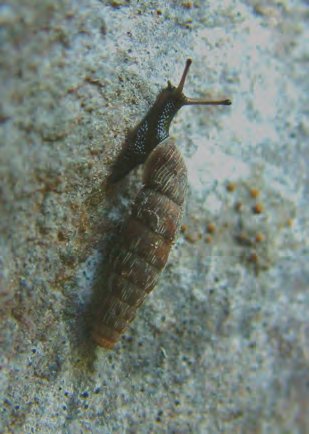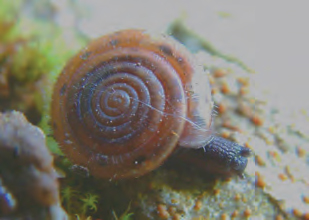|
A holiday to Bulgaria as a participant in an organized botanical tour of the western mountain regions in June 2005 offered me my first encounter with the land snails of this important region. The areas visited were the Vitosha, Rila, Pirin and Rhodope mountain areas together with brief visits to other sites en route. These regions contain a high number of recorded endemic terrestrial mollusc species, with between 6 and 14 species for each. Identification was difficult for many species due to the lack of easily obtainable identification guides so there is a caveat that the species names offered here are from identifications made to the best of my ability, however I would welcome any feedback or comments from those who have a more expert knowledge of the fauna of the Balkan area. My first two nights were spent at a hotel in the Vitosha mountain national park. This is a forested area with areas of higher alpine meadows and bog well known for its endemic plants together with a viable population of both wolves and brown bears. My first encounter however was with a colony of particularly fine live specimens of a much smaller species, the “Bulin”, Ena montana (Drap. 1801) [Figure 1] under mossy leaf litter near a path at the edge of the forest at c.1800m. The path opened out to higher damp alpine meadows with streams and granite boulders. The temperature must have been not much above freezing since there were signs of melting pockets of snow. Underneath the overhang of one of these boulders a number of small clausiliids, possibly Clausilia pumila C. Pfeiffer, 1828, were aestivating. Two forms of another member of the Enidae, Chondrula tridens (O.F. Muller, 1774), were found at less acidic locations a few miles away; the typical form under hawthorn bushes in a meadow by the road at Dregaletsy village south of Sophia and a larger more robust form with a thickened lip (possibly subspecies albolimbata (L. Pfeiffer, 1859)) under limestone boulders beneath an oak tree in fields above Bosnek village. In a ditch by a road near the hotel typical forms of the Roman Snail Helix pomatia (L.1758) were common as well as attractive specimens of Arianta aethiops (Bielz, 1867) [Figure 2] with glossy greenish brown shells. On the journey south from this area, in a field c. 40km south of Sophia (N42º 24.231 E23º 07.551) , aestivating in a well and on the stems of Hemlock (Conium maculatum) were both adult and juvenile specimens of the large Helicid Helix lucorum (L.1758) [Figure 3] together with many Monacha cartusiana (Muller, 1774) on grasses and herbs. A brief visit to the forests of Naroden Park in the Rila mountains above Rila Monastery (N42º 09.34 E22º 24.26) yielded a vitrinid with a compressed auriculate shell (probably Eucobresia diaphana (Drap., 1805) [Figure 4] under damp logs by a forested stream. Next followed two days staying in the area of the Pirin Mountains National Park. This area of Bulgaria is very varied, with over 100 high peaks at over 2000 metres, alpine meadows dotted with over 80 glacial lakes, forested hillsides and valleys and exposed cliff faces. Both limestone and acidic rocks are exposed. The more obvious snails once again included Helix pomatia but there were also the large elongate-ovoid, blunttipped and black striped shells of Zebrina detrita (Muller, 1774), particularly common on a limestone cliff next to a path above the Banderitsa mountain chalet at c.1900m. In this same area, beneath small limestone boulders were specimens of a disc-like Lindholmiola (possibly the local Lindholmiola contorta pirinensis Jaeckel 1954). Abundant by rocks on an exposed bend in the road were shells of a small Helicella species. Under small boulders near our hotel were specimens of Oxychilus glaber (Rossmassler, 1835) and the more familiar O. draparnaudi (Beck, 1837). On the journey south from this area, a stop at a field discovered a large Cepaea, C. vindobonensis (Ferussac, 1821) [Figure 5], aestivating on flower and grass stems whilst black storks (Ciconia nigra) flew overhead. The final destination on this tour was the Rhodope mountain region, close to the border with Greece. The hotel was in the mountain resort of Pamporovo, an area which is now sadly being developed at a rapid rate for the growing winter sports holiday industry however the stay here yielded some interesting species and included a trip to the spectacular limestone gorge of Trigrad. Species found in localities near Pamporovo included Truncatellina cylindrica (Ferussac, 1807) common in loose soil on an east facing limestone cliff; Zonitoides nitidus (O.F. Muller, 1774) in a marshy area by a water seepage at the bottom of a spectacular orchid field and Helicella obvia (Menke, 1828) on Verbascum in a road layby. Finally the Trigrad Gorge area yielded the most varied and interesting species of the trip. Helicids included a pale, thin walled, variety of Helix pomatia (probably var. tenuis Baudon 1884) [Figure 6] that was common on vegetation at the base of the cliff whilst the large depressed glossy and striped snails Helicigona rumelica balconica Kobelt [Figure 7] were common under leaves and in cracks of the limestone cliffs; Perforatella (Monachoides) incarnata (O.F.Muller, 1774) and Euomphalia strigella (Drap, 1801) were also found. Clausiliids, mostly in leaf litter, included large Macedonica fraudenfeldi (Rossmassler, 1856), Macrogastra ventricosa (Drap., 1801) [Figure 8] and Lacinaria plicata (Drap. 1801) [Figure 9]. Also in leaf litter was a second Lindholmiola species, this time L. girva (Frivaldszky, 1835) [Figure 10] which has distinct hairs and in the Rhodopi region grows to a shell diameter of 14mm. On shaded parts of the cliff were small dark Chondrina clienta (Westerlund, 1883). Finally in an area to the south of the gorge, right on the border with Greece (we knew this because here we were “trailed” by a car of Bulgarian border police!), in the cracks of a small limestone outcrop at N41º 34.492 E24º 24.290, was a colony of the elegant striped cylindrically fusiform snails Chondrus zebra tantalus (Pfeiffer, 1868). Although this was not specifically a conchologically based trip, this vacation gave me an introduction to the molluscan fauna (and other flora and fauna) of this fascinating area and I would recommend a visit to anyone wishing to explore the species present in this part of the Balkans. AcknowledgementsI would like to thank Alan Outen for his informative leadership of this tour and for passing on details of site coordinates and also to Dimitar (Mitko) Stofanov of Sophia Natural History Museum for information on local habitats and species. ReferencesGrossu, A.V. 1955 Fauna Republicii Populare Romine: Mollusca, Gastropoda Pulmonata. Academy of the People’s Republic of Romania. Grossu, A.V. 1983 Gastropoda Romaniae 4: Ordo Stylommatophora. Editura Litera, Bucarest. Kerney, M.P., Cameron, R.A.D. and Jungbluth, J.H. 1979. Die Landschnecken Nord- und Mitteleuropas. Paul Parey, Hamburg and Berlin. Pfleger, V. and Chatfield, J. 1988 A guide to Snails of Britain and Europe. Hamlyn, London. Web ref.: www.animalbase.unigoettingen. de/zooweb/servlet/Anima lBase/home |
Image 1
Image 2
Image 3
Image 4
Image 5
Image 6
Image 7
Image 8
Image 9
Image 10 |


